Electromagnetic Shielding Properties of Knitted Fabric Made from Polyamide Threads Coated with Silver
Abstract
1. Introduction
- absorption,
- reflection,
- secondary reflection.
2. Materials and Methods
2.1. Scanning Electron Microscopy (SEM)
2.2. Measuring the Shielding Effectiveness (SE) for Microwave Radiation
- temperature 23 ± 1 °C,
- relative humidity 50 ± 10%.
- a measuring instrument: NARDA SRM 3000,
- an HP 8350 B signal generator,
- an IEV horn antenna: Industrija za elektrozveze (Telecommunication Industry), Ljubljana, Type A12,
- a wooden frame, in which a sample of PA/Ag material of 1 m × 1 m was placed.
- E0 is the field level without protection (shield),
- E1 is the field level with protection (shield).
- SE0 represents the initial shielding effectiveness of the PA/Ag knitted fabric,
- SEP represents the shielding effectiveness of the PA/Ag knitted fabric after the 1st, 3rd, 5th, 7th, and 10th dry cleaning cycles,
- SEW represents the shielding effectiveness of the PA/Ag knitted fabric after the 1st, 3rd, 5th, 7th, and 10th wet cleaning cycles.
3. Results and Discussion
4. Conclusions
Author Contributions
Funding
Institutional Review Board Statement
Informed Consent Statement
Data Availability Statement
Acknowledgments
Conflicts of Interest
References
- Ozen, M.S.; Sancak, E.; Beyit, A.; Usta, I.; Akalin, M. Investigation of electromagnetic shielding properties of needle-punched nonwoven fabrics with stainless steel and polyester fiber. Text. Res. J. 2013, 83, 849–858. [Google Scholar] [CrossRef]
- Chen, H.; Lee, K.; Lin, J.; Koch, M. Comparison of Electromagnetic Shielding Effectiveness Properties of Diverse Conductive Textiles via Various Measurement Techniques. J. Mater. Process. Technol. 2007, 192–193, 549–554. [Google Scholar] [CrossRef]
- Wang, X.; Liu, Z.; Jiao, M. Computation Model of Shielding Effectiveness of Symmetric Partial for Anti-Electromagnetic Radiation Garment. Prog. Electromagn. Res. B 2013, 47, 19–35. [Google Scholar] [CrossRef]
- Kim, H.-R.; Fujimori, K.; Kim, B.-S.; Kim, I.-S. Lightweight Nanofibrous EMI Shielding Nanowebs Prepared by Electrospinning and Metallization. Compos. Sci. Technol. 2012, 72, 1233–1239. [Google Scholar] [CrossRef]
- Prudnik, A.M.; Zamastotsky, Y.; Siarheyev, V.; Siuborov, V.; Stankevich, E.; Pobol, I. Electromagnetic Interference Shielding Properties of the Cu, Ti and Cr Coatings Deposited by Arc—PVD on Textile Materials. Electr. Rev. 2012, 6, 81–83. [Google Scholar]
- Sonehara, M.; Noguchi, S.; Kurashina, T.; Sato, T.; Yamasawa, K.; Miura, Y. Development of an Electromagnetic Wave Shielding Textile by Electroless Ni-Based Alloy Plating. IEEE Trans. Magn. 2009, 45, 4173–4175. [Google Scholar] [CrossRef]
- Maity, S.; Singha, K.; Debnath, P.; Singha, M. Textiles in Electromagnetic Radiation Protection. J. Saf. Eng. 2013, 2, 11–19. [Google Scholar]
- Roh, J.-S.; Chi, Y.-S.; Kang, T.J.; Nam, S.-W. Electromagnetic shielding effectiveness of multifunctional metal composite Fabrics. Text. Res. J. 2008, 78, 825–835. [Google Scholar] [CrossRef]
- Tunakova, V.; Tunak, M.; Tesinova, P.; Seidlova, M.; Prochazka, J. Fashion clothing with electromagnetic radiation protection: Aesthetic properties and performance. Text. Res. J. 2020, 90, 2504–2521. [Google Scholar] [CrossRef]
- Perumalraj, R.; Dasaradan, B.S.; Anbarasu, R.; Arokiaraj, P.; Harish, S.L. Electromagnetic Shielding Effectiveness of Copper Core Woven fabrics. J. Text. Inst. 2009, 100, 512–524. [Google Scholar] [CrossRef]
- Das, A.; Kothari, V.K.; Kothari, A.; Kumar, A. Effect of Various Parameters on Electromagnetic Shielding Effectivenes of Textile Fabrics. Indian J. Fibers Text. Res. 2009, 34, 144–148. [Google Scholar]
- Usta, I.; Sancak, E.; Yüksek, M.; Beyit, A.; Atak, O.; Senyurek, V. Effect of Metal Filament Wire Containing Knitting Fabrics on Electromagnetic Shielding Effectiveness (EMSE). In Book of Proceedings of the 5th International Textile, Clothing & Design Conference 2010— Magic World of Textile; Dragčević, Z., Hursa Šajatović, A., Vujasinović, E., Eds.; University of Zagreb Faculty of Textile Technology: Zagreb, Croatia, 2010; pp. 271–276. [Google Scholar]
- Cheng, K.B.; Ramakrishna, S.; Lee, K.C. Development of Conductive Knitted Fabric Reinforced Thermoplastic Composites for Electromagnetic Shielding Applications. J. Thermoplast. Compos. Mater. 2000, 13, 378–399. [Google Scholar] [CrossRef]
- Cheng, K.B.; Ramakrishna, S.; Lee, K.C. Electromagnetic Shielding Effectiveness of Copper Glass Fiber Knitted Fabric Reinforced Polypropylene Composites—Part A. Composites 2000, 31, 1039–1045. [Google Scholar] [CrossRef]
- Koprowska, J.; Pietranik, M.; Stawski, W. New Type of Textiles with Shielding Properties. Fibres Text. East. Eur. 2004, 12, 39–42. [Google Scholar]
- Bergman, A.; Michielssen, E.; Taub, A. Comparison of Experimental and Modeled EMI Shielding Properties of Periodic PorousxGNP/PLA Composites. Polymers 2019, 11, 1233. [Google Scholar] [CrossRef] [PubMed]
- Safarova, V.; Militky, J. Multifunctional Metal Composite Textile Shields Against Electromagnetic Radiation—Effect of Various Parameters on Electromagnetic Shielding Effectiveness. Polym. Compos. 2015, 38, 309–323. [Google Scholar] [CrossRef]
- Mistik İlker, S.; Sancak, E.; Ovali, S.; Akalin, M. Investigation of Electromagnetic Shielding Properties of Boron, Carbon and Boron–Carbon Fibre Hybrid Woven Fabrics and their Polymer Composites. J. Electromagn. Waves Appl. 2017, 31, 1289–1303. [Google Scholar] [CrossRef]
- Rajendrakumar, K.; Thilagavathi, G. Electromagnetic Shielding Effectiveness of Copper/PET Composite Yarn Fabrics. Indian J. FibreText. Res. 2012, 37, 133–137. [Google Scholar]
- Ortlek, H.G.; Kilic, G. Electromagnetic Shielding Characteristics of Different Fabrics Knitted from Yarns Containing Stainless Steel Wire. Ind. Text. 2011, 62, 304–308. [Google Scholar]
- Özkan, İ. Investigation on the electromagnetic shielding performance of copper plate and copper composite fabrics: A comparative study. Tekst. Ve Konfeksiyon 2020, 30, 156–162. [Google Scholar] [CrossRef]
- Neruda, M.; Vojtech, L. Electromagnetic Shielding Effectiveness of Woven Fabrics with High Electrical Conductivity: Complete Derivation and Verification of Analytical Model. Materials 2018, 11, 1657. [Google Scholar] [CrossRef] [PubMed]
- Hauthal, H.G. Washing at Low Temperatures–Saving Energy, Ensuring Hygiene. Tenside Surfactants Deterg. 2012, 49, 171–177. [Google Scholar] [CrossRef]
- Lavastir, G.P. Wet cleaning. Detergo 2007, 5, 28–37. [Google Scholar]
- Šaravanja, B.; Pušić, T.; Malarić, K.; Hursa Šajatović, A. Durability of Shield Effectiveness of Copper-Coated Interlining Fabrics. Tekstilec 2021, 64, 25–31. [Google Scholar] [CrossRef]
- EEE STD 299 Standard Method for Measuring the Effectiveness of Electromagnetic Shielding Enclosures. 2006. 299. Available online: https://standards.ieee.org/standard/299-2006.html (accessed on 5 February 2021).
- MIL-STD-285, Military Standard: Attenuation Measurements for Enclosures, Electromagnetic Shielding. 1956. Available online: http://everyspec.com/MIL-STD/MIL-STD-0100-0299/MIL-STD-285_25102/ (accessed on 5 February 2021).
- ASTM D-4935-89 Standard Test Method for Measuring the Electromagnetic Shielding Effectiveness of Planar Materials. 1999. Available online: https://www.astm.org/Standards/D4935.htm (accessed on 5 February 2021).
- Čunko, R.; Andrasy, M. Vlakna; Zrinski d.d.: Čakovec, Croatia, 2005; ISBN 978-953-1-550895. [Google Scholar]
- Schwarz, A.; Kazani, I.; Cuny, L.; Hertleer, C.; Ghekiere, F.; De Clercq, G.; De Mey, G.; Van Langenhove, L. Electro-conductive and elastic hybrid yarns—The effects of stretching, cyclic straining and washing on their electro-conductive properties. Mater. Des. 2011, 32, 4247–4256. [Google Scholar] [CrossRef]
- Afilipipoaei, C.; Teodorescu-Draghicescu, H. A Review over Electromagnetic Shielding Effectiveness of Composite Material. Proceedings 2020, 62, 3023. [Google Scholar] [CrossRef]
- Kayacan, O. The effect of washing processes on the electromagnetic shielding of knitted fabrics. Tekst. Ve Konfeksiyon 2014, 24, 356–362. [Google Scholar]
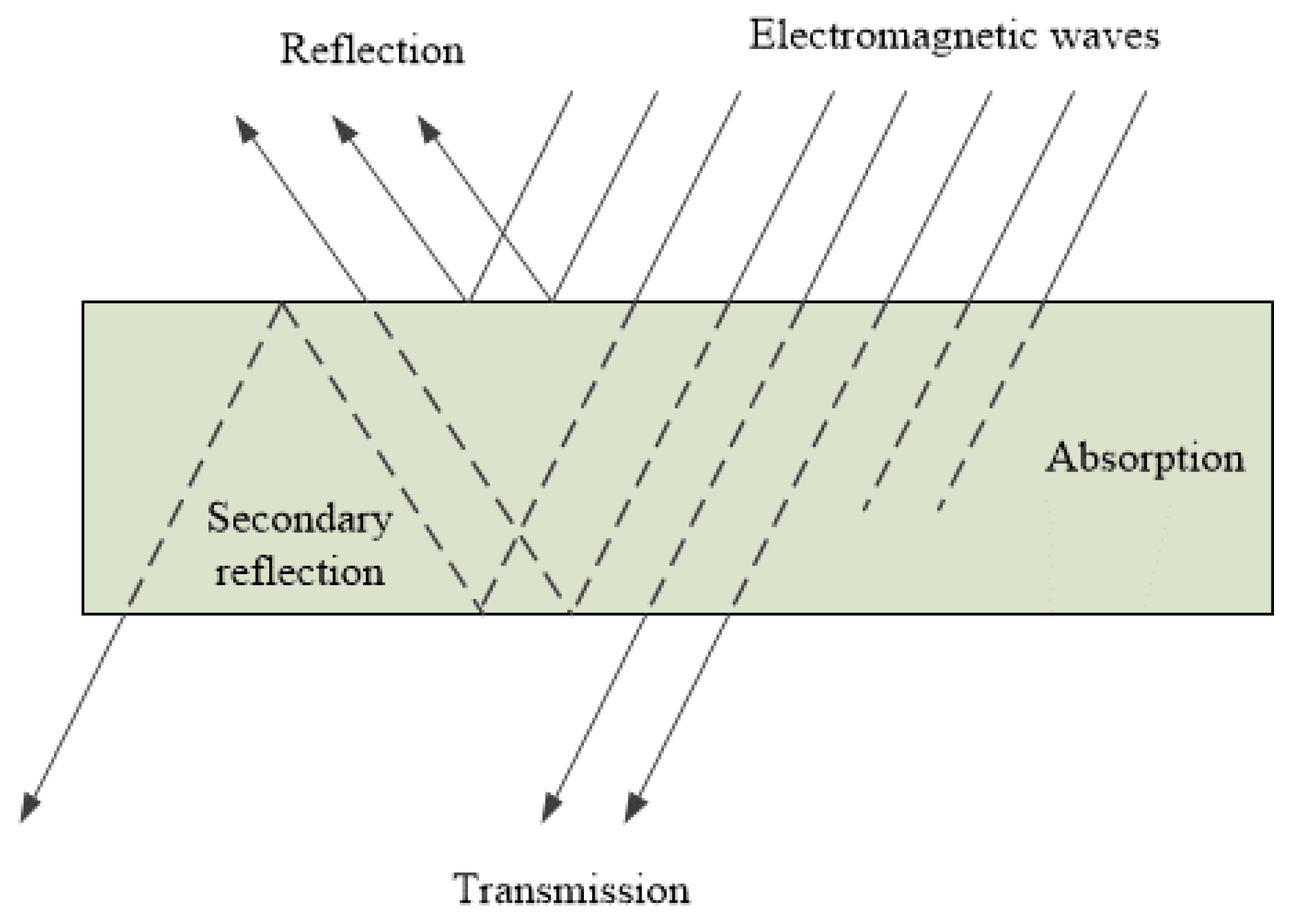

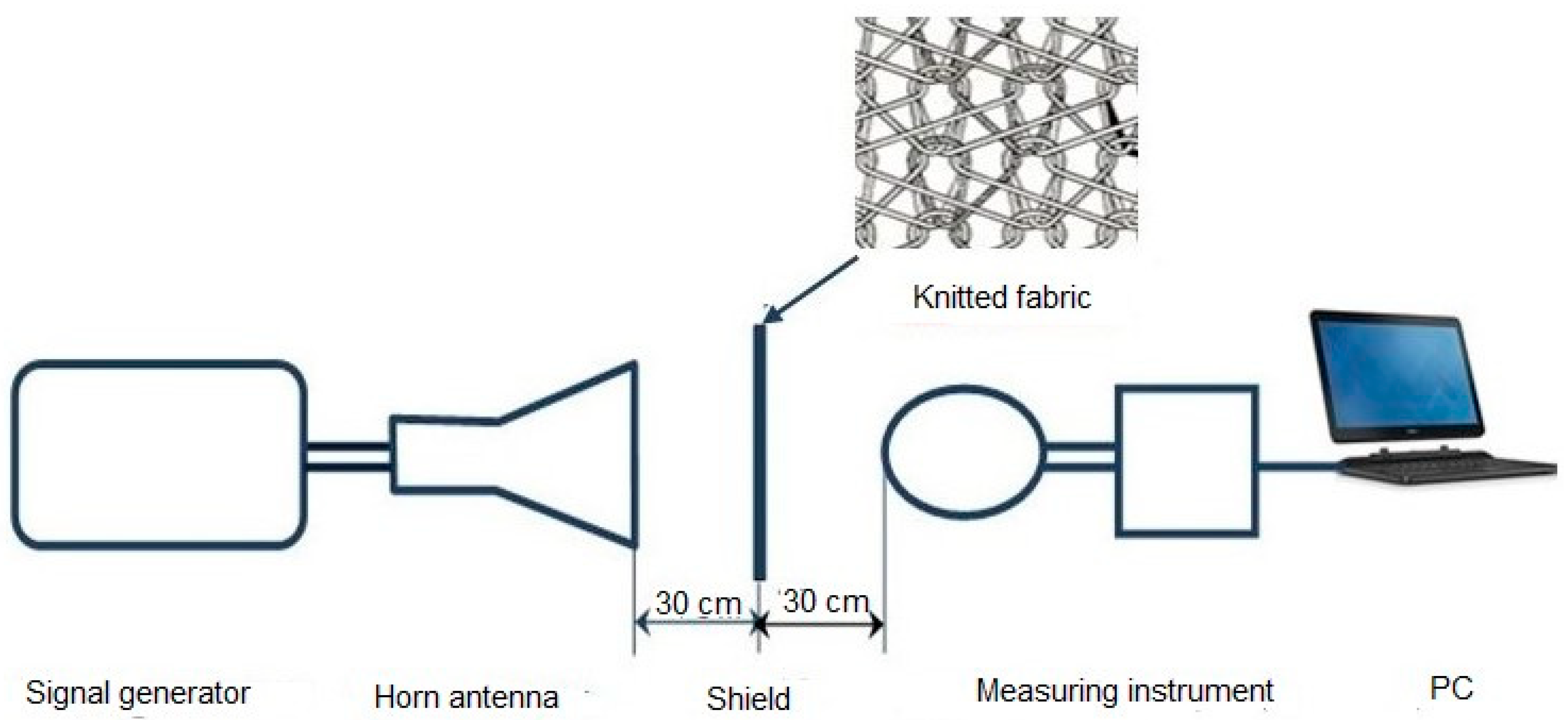
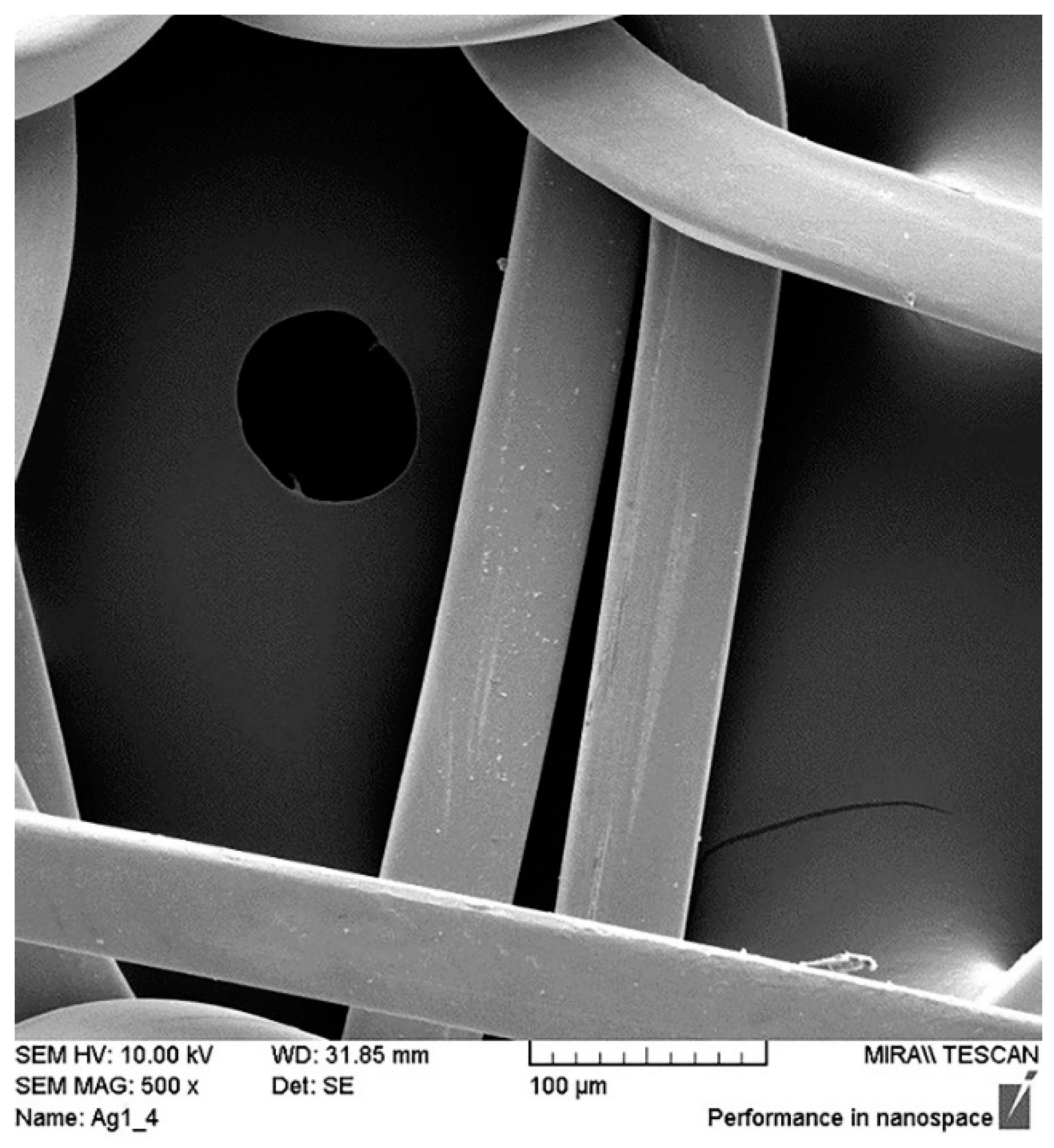

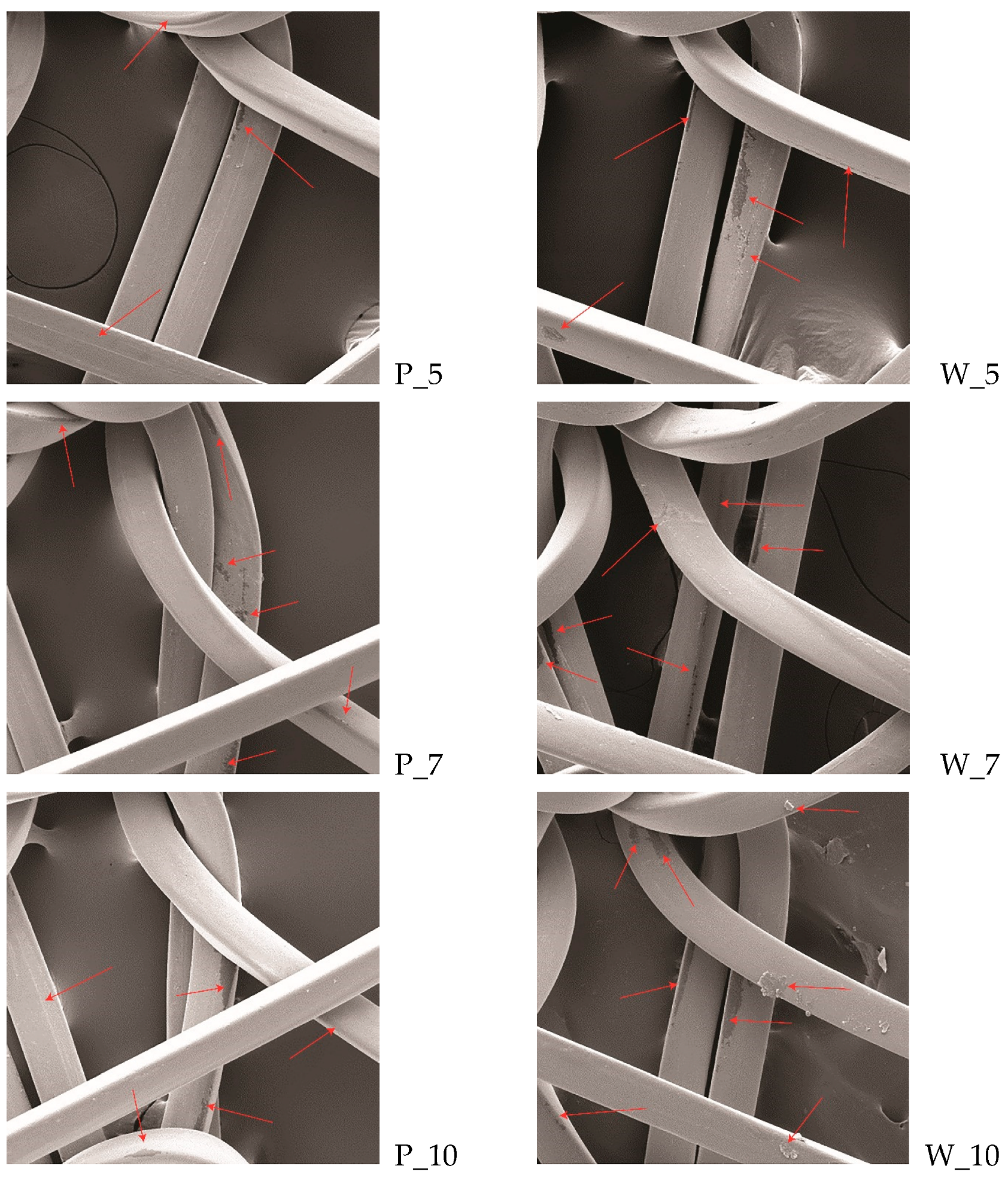

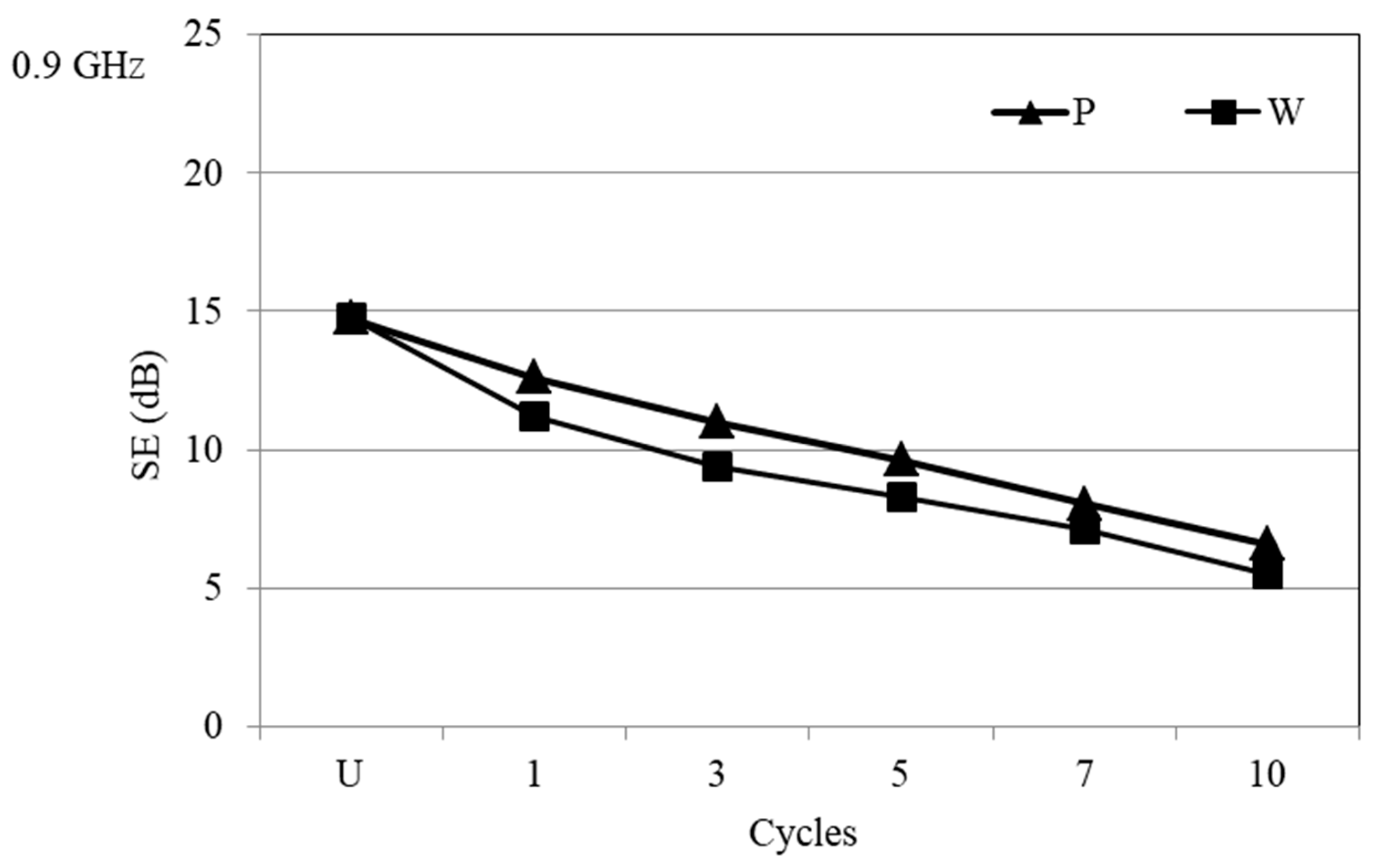
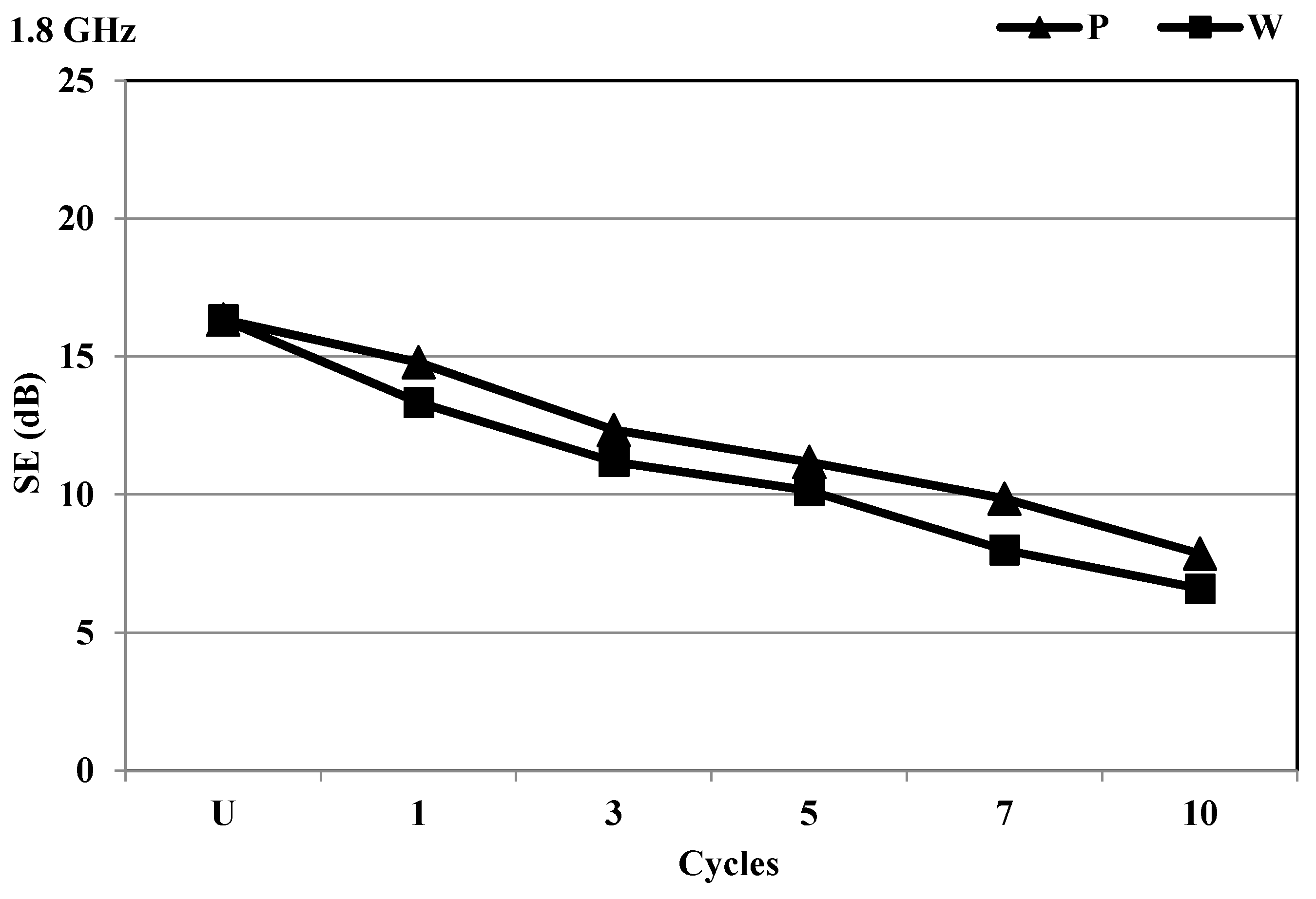

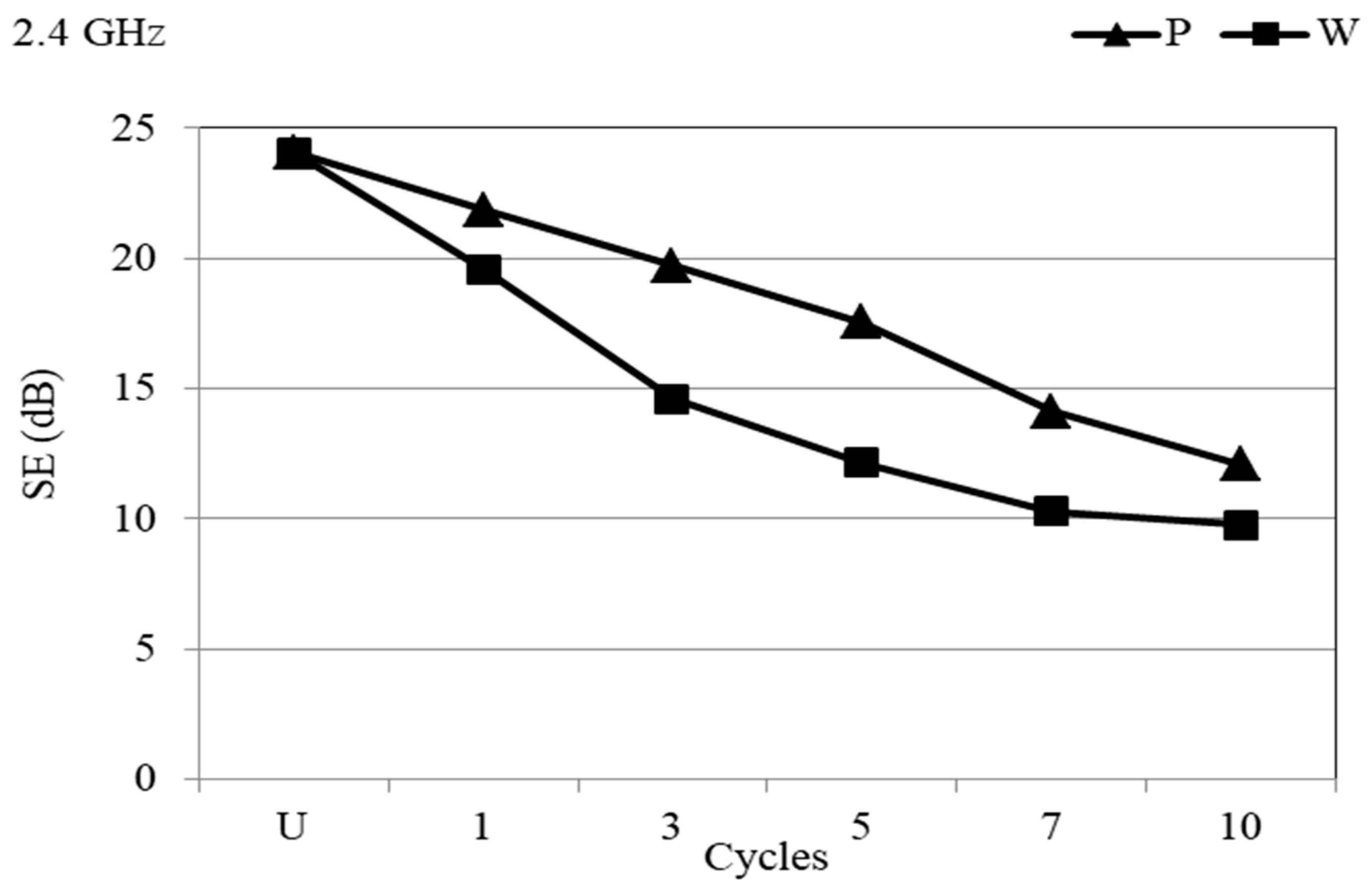
| Composition PA/Ag (%) | 80/20 | |
| Mass per unit area (g/m2) | 35.8 | |
| Density (course/wale)/100 mm | 150/125 | |
| Charmeuse knitted structure | digital microsope images | |
| magnification 50× | magnification 250× | |
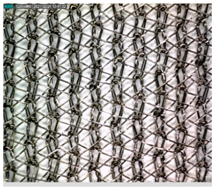 | 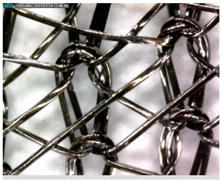 | |
| PA/Ag Fabric | Thickness (mm) |
|---|---|
| Untreated | 0.150 |
| 10 cycles treatment with P | 0.162 |
| 10 cycles treatment with W | 0.165 |
| f (GHz) | Dry Cleaning Cycles | ||||
|---|---|---|---|---|---|
| dSE (dB) | |||||
| P_1 | P_3 | P_5 | P_7 | P_10 | |
| 0.9 | 2.2 | 3.8 | 5.2 | 6.7 | 8.2 |
| 1.8 | 1.5 | 4.0 | 5.2 | 6.5 | 8.5 |
| 2.1 | 2.3 | 4.6 | 6.5 | 8.4 | 9.5 |
| 2.4 | 2.2 | 4.3 | 6.5 | 9.9 | 11.9 |
| f (GHz) | Wet Cleaning Cycles | ||||
|---|---|---|---|---|---|
| dSE (dB) | |||||
| W_1 | W_3 | W_5 | W_7 | W_10 | |
| 0.9 | 3.6 | 1.8 | 6.4 | 7.6 | 9.3 |
| 1.8 | 4.3 | 6.2 | 7.9 | 9.8 | 10.9 |
| 2.1 | 4.3 | 6.2 | 7.9 | 9.8 | 10.9 |
| 2.4 | 4.5 | 9.5 | 11.9 | 13.8 | 14.3 |
Publisher’s Note: MDPI stays neutral with regard to jurisdictional claims in published maps and institutional affiliations. |
© 2021 by the authors. Licensee MDPI, Basel, Switzerland. This article is an open access article distributed under the terms and conditions of the Creative Commons Attribution (CC BY) license (http://creativecommons.org/licenses/by/4.0/).
Share and Cite
Pušić, T.; Šaravanja, B.; Malarić, K. Electromagnetic Shielding Properties of Knitted Fabric Made from Polyamide Threads Coated with Silver. Materials 2021, 14, 1281. https://doi.org/10.3390/ma14051281
Pušić T, Šaravanja B, Malarić K. Electromagnetic Shielding Properties of Knitted Fabric Made from Polyamide Threads Coated with Silver. Materials. 2021; 14(5):1281. https://doi.org/10.3390/ma14051281
Chicago/Turabian StylePušić, Tanja, Bosiljka Šaravanja, and Krešimir Malarić. 2021. "Electromagnetic Shielding Properties of Knitted Fabric Made from Polyamide Threads Coated with Silver" Materials 14, no. 5: 1281. https://doi.org/10.3390/ma14051281
APA StylePušić, T., Šaravanja, B., & Malarić, K. (2021). Electromagnetic Shielding Properties of Knitted Fabric Made from Polyamide Threads Coated with Silver. Materials, 14(5), 1281. https://doi.org/10.3390/ma14051281







